Long-term test review of the Fiat Fullback pickup on Parkers Vans
Report 5: Visiting relatives
No, not another drive – the Fiat’s platform-mate comes to say hello
In theory, you could take the stance that the Fiat Fullback and Mitsubishi L200 are different offerings aimed at different buyers. That is, on the whole, the approach most manufacturers and people committed to their brand loyalty would favour.
When so little differs between the two, though, you’re really pushing the boundaries of cognitive dissonance to insist that they are not the same car. Like Clarke Kent taking off his glasses, you wonder how with press shots and close friends knowing both the mild-mannered reporter and the otherworldly superhero, Superman’s identity remained a mystery.
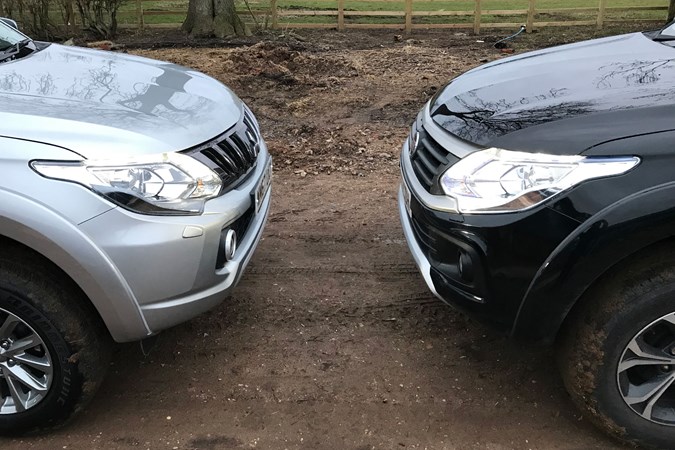
L200 vs Fullback: Different identity, same ability – until now
Previously, take off the glasses on whichever model you felt to be the mild-mannered one, and you’d be left with a sense of confusion. Transformed, it would try to perform a feat of incredible strength, and maybe grunt a bit and glare with laser-vision eyes, but the new logo on the chest would have abilities no different to the daily suit.
Now there’s some superhuman – sorry, truck – strength and the Fiat’s revealed to be the meek counterpart. Mitsubishi has uprated the specifications of the L200 and it can tow 3,500kg vs. the Fiat’s 3,100kg, even though the total load capacity is unchanged. Being able to transfer 400kg of load from the pickup bed to the tow hitch to compensate for a heavier trailer seems useful given the upmarket models of both pickups have bumpers that prevent 180 degree tailgate drops and easy loading.
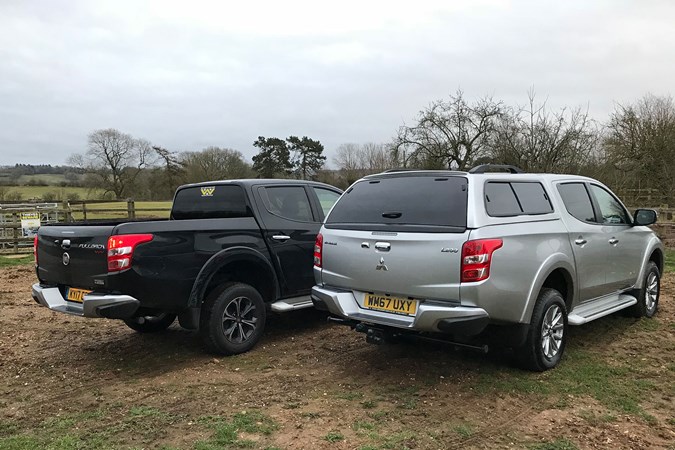
It’s worth noting that the changes make the L200 the class leader for towing 3,500kg while carrying stuff in the loadbed as well. No rival can match its combined capacity.
Fiat will probably follow suit – both pickups are made on the same production line, based on the same chassis, and the effort required to separate the Mitsubishi, Fiat and (for some markets) Dodge versions on different frames would surely be more effort than applying the modifications across the board. Until the Fullback is homologated or re-rated for the new capacity though, you might prefer the L200.
What are the differences between the L200 and Fiat Fullback, then?
Comparing them back to back, not much at all. Between the 2018 L200 Warrior and my 2017 Fullback, the ride height is the same, the tyres are the same, the trim has the same appearance and stitching pattern, the lights are the same...
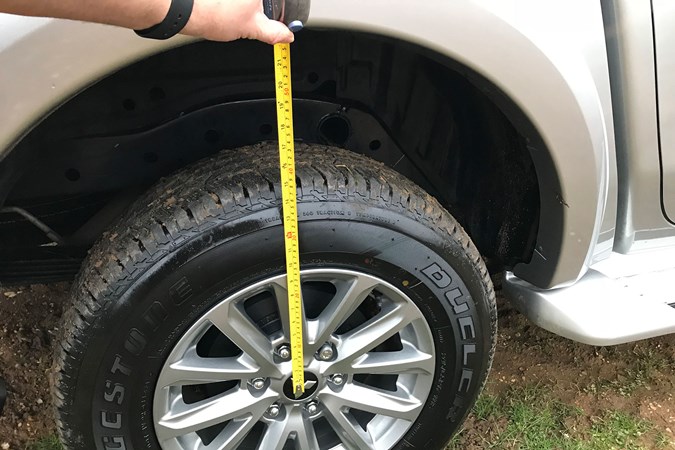
There are more differences between a Fiat Fullback 180 LX and a Fullback Cross than an L200 Warrior and the Fiat, in fact.
They do feel different behind the wheel, however. Some of that will be down to the difference in mileage; with 5,000 miles on the clock, my Fullback has had more time to bed in than the L200 we compared it with. Ride quality on the Fiat does have a softer edge over high frequency imperfections, and most confusing, the seats on the Fiat feel like they have a slightly different density of foam – rather like a mattress topper taking the edge off a firm base, both are supportive and comfortable, but the Fiat has always felt well padded for a pickup.
They also smell different. Vastly so. The Fullback’s interior has a stronger leather aroma than the L200’s rather plasticky ambience.
Whether Fiat will move to the Mitsubishi SDA infotainment system is yet to be seen, but if you like Apple CarPlay, or Android Auto (and the ability to use Waze navigation) then the L200 is the one to have. It loses the CD drive and built in navigation; if you don’t use a smartphone, the Fiat is the better choice.
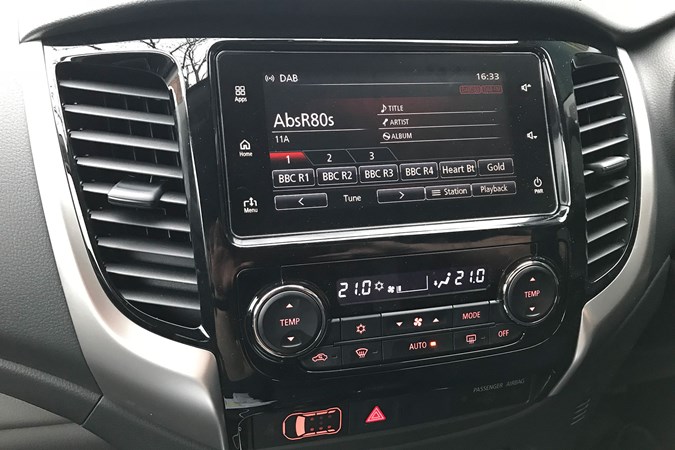
Finally, there is one measurable difference. Mitsubishi’s new steering wheel – which echoes the design of their latest SUVs in the chrome signature – is a 15-inch affair with a sculpted rim that is up to 34.5mm in diameter; the Fullback’s wheel is a leather-trimmed 14-inch model that is about 30mm diameter but still feels chunky in your hands.
Smaller wheels generally feel more direct, and that affects the feeling of control and feedback.
L200 and Fiat Fullback – manual vs automatic
Choosing the automatic version of either pickup is going for some of the oldest gearbox technology offered in 2018 – a five-speed torque converter setup. It is smooth, and will be reliable – and the paddle shifters are so useful that every time I drive an automatic pickup without them, it’s like having a vital control removed.
However, It’s lower geared at motorway speeds, and thirstier too.
A direct comparison is unfair as the L200 had a Truckman hard top fitted, changing the aerodynamics (and adding wind noise), but the taller gearing of the six-speed manual ensured the L200 returned closer to 37mpg on the motorway where my Fullback rarely exceeds 33mpg, and sits a touch under 2,000 rpm at 70mph where the automatic model is around 2,250rpm.
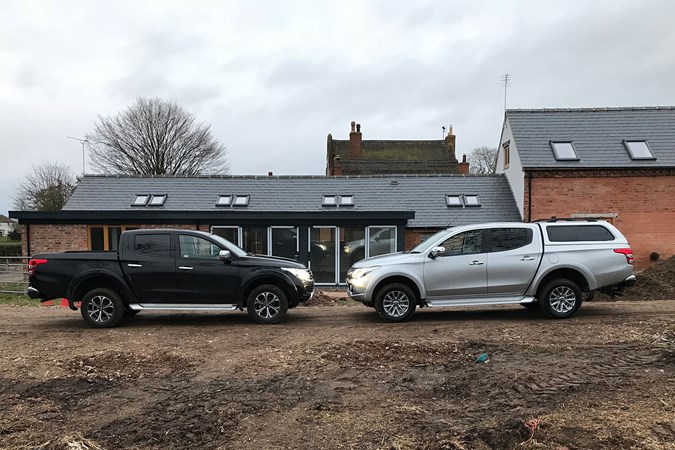
The side effect of that gearing is not only a more refined truck at national speed limits; it’s also quite capable of cruising effortlessly in typical motorway traffic when lightly loaded. Where limits allow, the manual L200/Fullback will cover ground rapidly.
Tradeoff is the rather ponderous manual gearchange and an increase in road noise coming into the cabin, which appears to be due to slightly reduced centre tunnel insulation.
What about the Fullback Cross?
This is my own Fiat, so driving other pickups always runs the risk of feeling like ‘look at what you could have won’. So far, the X-Class, Amarok, Navara and Isuzu D-Max have been driven and handed back without tears; there are definite pros and cons with each in technical ability and styling, but the overall package of ability, looks and cost the Fiat Fullback LX offers has remained the most appealing in my opinion.
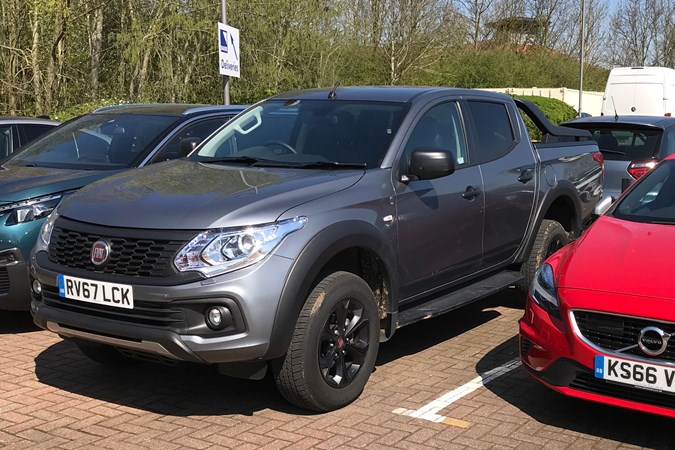
The Cross has more detail changes and it’s come closest to making me wish I’d waited until it came on sale. The load liner is a rather cleaner design, to allow fitment of the stylish sports bars. The soft-opening tailgate is very welcome, though it still doesn’t lock, and the side steps are a much cleaner, subtle design and more suited to families with children climbing into the car.
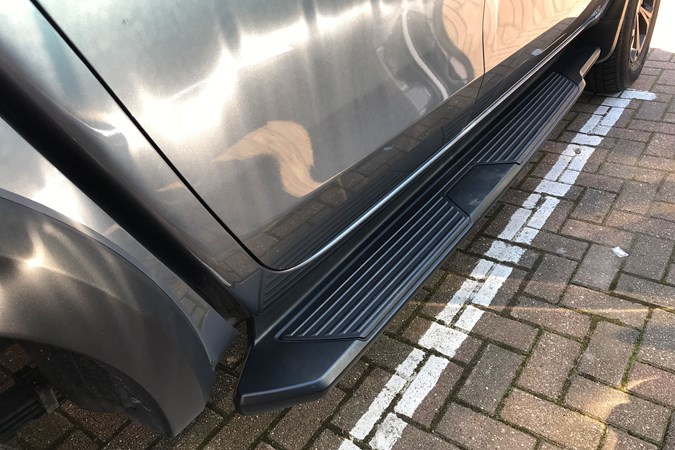
Oddly, the keyless ignition system has given way to a traditional key.
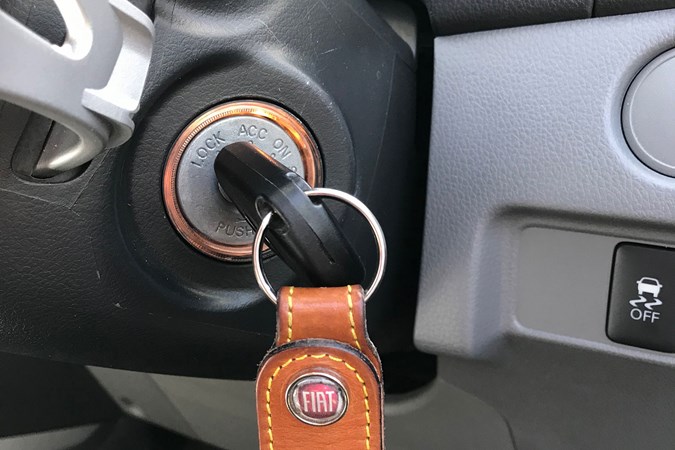
Subjectively, the textured unpainted wheel arch extensions and black grille are also rather more attractive.
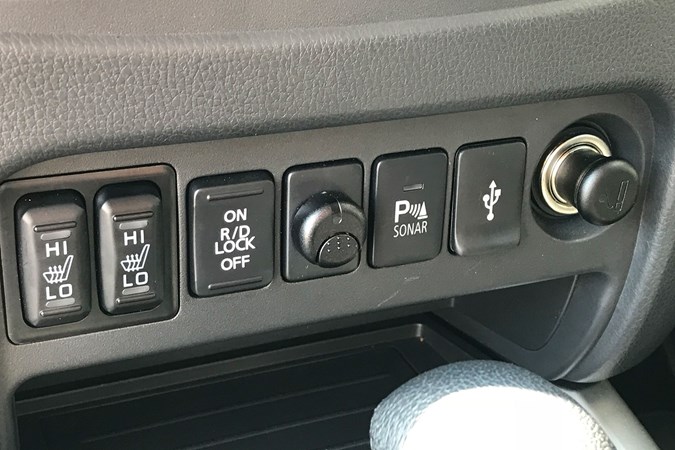
Technically, though, the Cross has an additional level of ability that is unique in the UK pickup market – it features selectable full time all-wheel drive in both automatic and manual versions, a locking centre differential and a locking rear differential. If you want an off-road pickup truck, the Cross is simply one of the best you can buy right now.
Fiat Fullback 180 LX Auto – 5,000 mile summary
With all that said, how’s my own Fiat doing? Brilliantly. Despite winter’s efforts I have seen no unsightly rust forming underneath, the wheels remain pristine, braking and steering are as good as the day I picked it up. It’s not had the use expected, but I’m pleased with the value and performance.
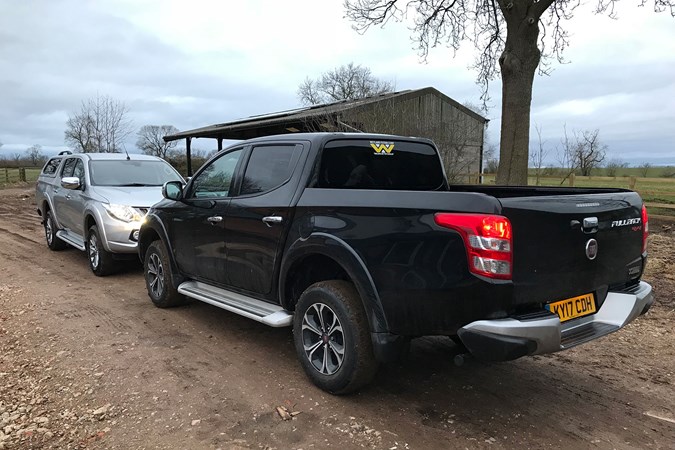
Though, we did just get a Ford Ranger in for test, and I really should have a go…
By Richard Kilpatrick
Mileage: 5,101
Actual fuel economy: 30.0mpg
Report 4: Crossing the border - Fiat fulfils its destiny (sort of)
Richard takes the Fiat to Scotland, choosing it over a luxury SUV...
Long-term reader(s) may recall that the original reason for getting a new car instead of a fleet of bangers was a plan; to help with working on renovating the family home in Scotland, I needed a new vehicle that could do 12,000 miles a year and be immensely practical. And that's been put on hold after getting a dream job testing cars.
Since then, the few times I’ve visited I’ve taken Parkers test cars - as the opportunities for good roads, and decent experience of vehicles we’re reviewing are too good to miss.
A free weekend, and a crammed-plan to visit my parents. The decision was made: the Fiat would make the journey that it had been expected to do twice a month, every month originally.
Up to ten hours of driving, in mixed conditions on mixed roads, and the sort of route that most people would choose an executive saloon to cover.
Fullback keeps having an empty back
The week before we’d originally planned to take my friend's children to visit their grandfather, and see how the pickup coped as a family vehicle; it failed at the first hurdle, as the expected overnight bags became spare bedding, toys, and other things that would not take kindly to being placed in the uncovered rear bed.
Even in the long-term Evoque we took instead, the kids were packed like sardines.
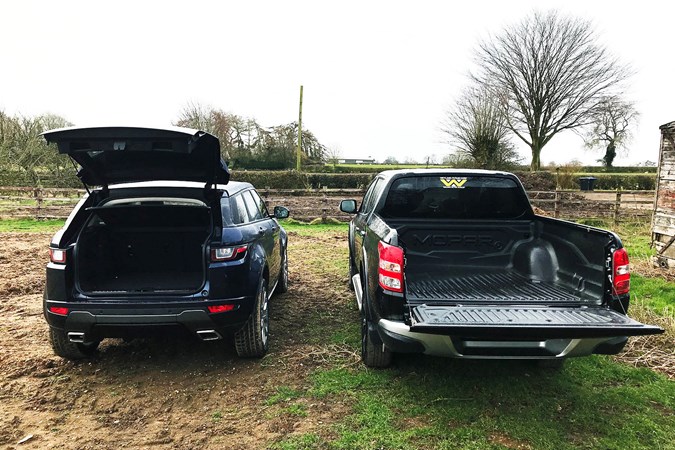
Lesson learned, then - get a load cover (or a hardtop) if you want to use your pickup for family duties, obviously.
This time, it was just us – so the rear seat served as a useful luggage area, and the capacious rear remained unspoiled and free to carry rain, leaves and whatever the local wildlife had chosen to drop in there that week.
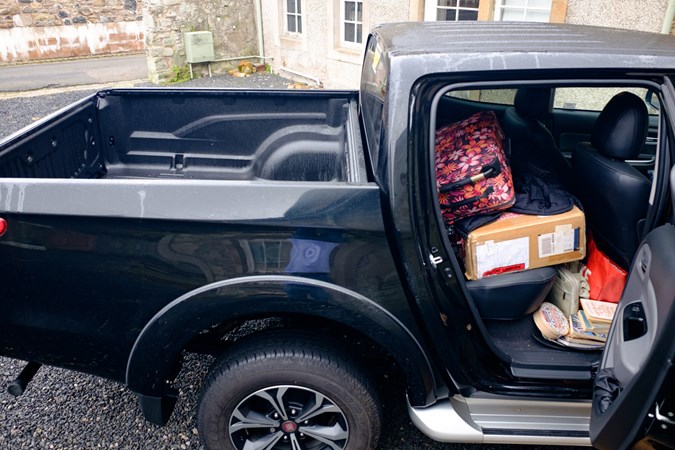
No matter what test cars pass by, there’s something pleasing about being back behind the wheel of my own truck. At the time of writing, the main car I’m driving for Parkers is a Range Rover Evoque HSE; almost £50,000 worth of leather-lined, all-wheel drive compact-ish luxury – it would be insane to compare the two.
Sanity isn’t something I’m often accused of, so here goes: The Fiat Fullback is in some aspects more relaxing than the Evoque, and subjectively has seats better suited for long drives, despite less adjustment.
How comfy the chairs in your car are is very much a matter of taste, but as Anna also commented how relaxed and comfortable the Fiat was compared to the Range Rover, it seems reasonable to think it’s not just a personal thing.
All of this assumes adhering to the speed limit of course, where the Fullback is happy to potter around. A conventional modern SUV or off-roader is more relaxed if you’re determined to (illegally) keep up with 85mph traffic on the faster stretches of the M1.
What may influence your decision is the news that the M1 has recently been fitted with stretches of variable-speed cameras - set to catch speeders at 70 even when the signs are off.
Taking the high road
M1? Nothing to report. A1(M)? Nothing to report. It gets interesting once the road veers off near Team Valley, taking the A696 through Ponteland and across to the A68 and Otterburn/Kielder reservoir. This fast, wide-open stretch is a destination as much as it is a route, often packed with keen bikers, drivers and waiting Police in summer. Winter can be treacherous, and we slow for emergency vehicles attending to an overturned small SUV just outside Belsay.

It’s also the first sign of home – reminiscent of teenage drives in an aircooled VW Beetle, lost at midnight on forestry tracks in the snow, without mobile phone, map or arguably, common sense. This time there’s not enough time to send the Fiat down those old unpaved roads around Newcastleton and Kielder, but there’s a dash of snow at the Scottish Border viewpoint to evoke memories.
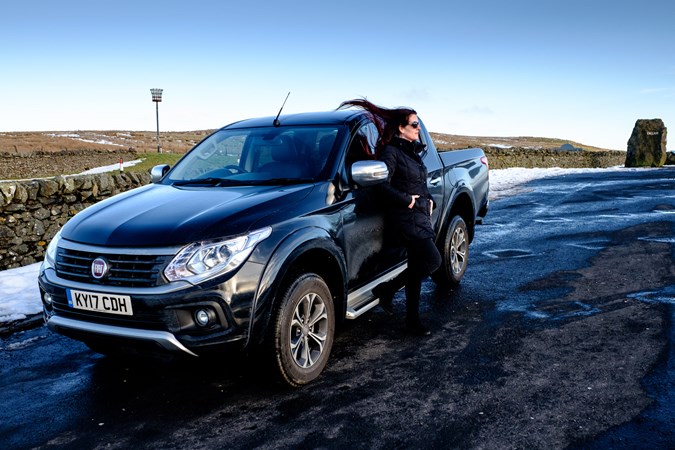
Here, the Fiat’s high driving position and large side windows make the landscape truly enjoyable. For the first time on the drive, the 2.4-litre engine is also asked to work a little harder, and the bane of pickups everywhere rears up; an oddly rutted stretch of road that causes the rear axle to skip a little as we head into Jedburgh.
It’s entirely predictable, and I still prefer the large-tyred, soft-sprung way the front suspension deals with unavoidable road damage that causes horrible jolts and noise in cars like the Evoque.
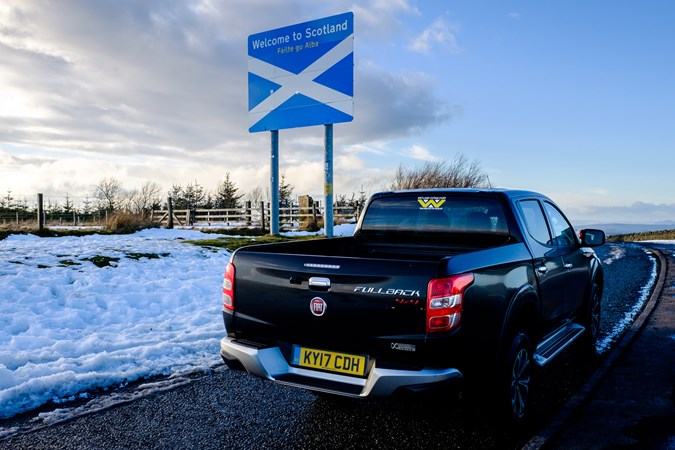
Once in Kelso, the Fullback patters across the wet cobbles securely. Home turf, and a swift glance at our reflection in the familiar windows of the Rendezvous chip-shop reinforces a bit of pride in this car too; it’s good looking (as is the L200), though the grille is perhaps a little low-rent with the matte painted silver. The higher specification Fullback Cross looks a little nicer.
Taking the low road
Barely any time to relax, and we’re off again, this time via Wooler. Worth stopping at is the Doddington Milk Bar, an ice-cream and milkshake parlour connected to a long established dairy in the town; somehow, I’d lived near here for two decades and missed it.
Wooler, like areas of Lincolnshire and East Anglia, has pockets of feeling like rural America and a neon 'open' sign beckons. After sampling liquorice, Jaffa Cake and honey ice-creams, with a large coffee in hand and cupholders at the ready, the Fiat plays to another past identity as we hit the long straight roads towards Alnwick.
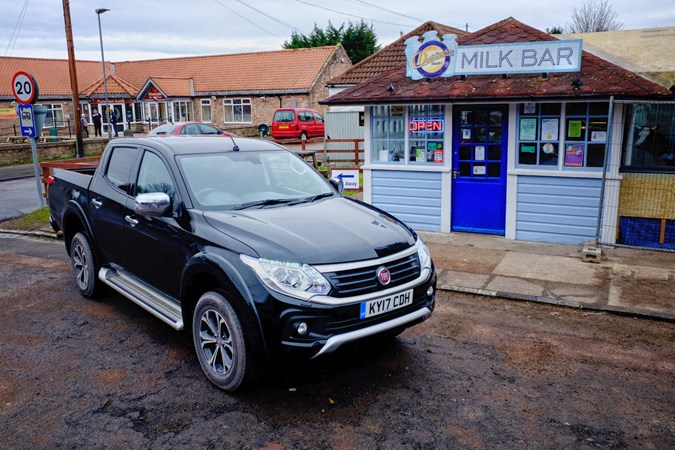
For once, Siri obeys a voice command and pops some Glenn Campbell over Bluetooth. Pickup culture is not yet at Oklahoma levels here, and the garish, extroverted creations that seek to recreate a Southern feel in the UK are a long way from the black Fiat’s understated presence. It needs a bit of chrome, perhaps. A long empty road in the mirror conjures memories of Route 66 as we search the telegraph poles for overloads - and clues to the next curve or hill.

Diverting into Newcastle’s Walker area to deliver a synthesizer serves as a useful reminder that the Fiat has a decent turning circle and wide enough track to make typical speed cushions a non-issue, and then the uneventful journey back to the Midlands. Out of 24 hours, 10 have been spent in the pickup’s cabin and we’re not fatigued at all. Anna’s praise for the subtly bolstered seats is unexpected, and despite enjoying those fast, hilly A-roads fully, economy has remained above 30mpg.
The next day I'm back in the Evoque and radio off, the roar of tyres, the occasional low-speed lurch from the nine-speed gearbox, and the wind noise around the door and mirrors is thrown into sharp relief after the serenity found in one of the UK’s cheapest lease pickups. The Range Rover is good, but should be for the money. The Fiat continues to be pleasantly surprising.
By Richard Kilpatrick
Mileage: 4,332
Actual fuel economy: 31.3mpg
Report 3: Snow-spotted Bengals and snow-spotted roads
After some feline relocation, the Fullback gets a taste of British winter...
For some inexplicable reason, there were few offers of test cars to help relocate an occasionally incontinent stressed out cat.

Faced with potentially three-and-a-half hours of M6, M5 and 'here be Dragons' in rural Devon, something motorway-friendly and full of driver assistance would have made sense. It's as if my colleages at Parkers were somehow worried their cars would be returned a little changed for their experience.
No matter. When I ordered it, the Fiat was chosen in part for the good ride (for a pickup) and well-matched engine/gearbox, and honestly after weeks of driving unfamiliar vehicles the idea of a weekend in my own car was tempting.
Before embarking on a long journey, it pays to know where your towel is. Ours were all over the back seats in anticipation of protests. Perhaps in defiance of such preparation, and perhaps due to the effective use of David Teie's 'Music for Cats' CD (it genuinely worked to calm her and silence anxious miaows), we all made it to Devon astonishingly calm and relaxed, with no unfortunate incidents.

Unwilling to make any stops, to minimise stress for the cat, a constant motorway speed was held for the entire journey in typically drizzly, overcast early winter weather; yet the Fiat's seats (which lack adjustable lumbar support) were spot on. Praise is presumably also owed to Mitshibishi for the overall level of refinement, mimimal wind noise and road noise. Fiat's suspension tuning certainly seems to work well in isolation; it will be interesting to compare it with an L200.
On arrival in the coastal towns, the Fullback also proved to be the perfect choice. As it is so easy to place on the road, the typical lane-and-a-half, high-hedgerow tunnels felt less claustrophobic. Aftermath of storms and flooding? No problem.

Was the Fiat Fullback the right choice?
A couple of weeks later, I would be behind the wheel of an Amarok and an X-Class. All of these premium pickups have list prices above £30,000, but with the discounts available on the Fiat it's far from competing for the same buyers. That's a shame - yes, the Amarok feels like a more mature, capable truck but it lacks the nimble, responsive driver experience and much of the interior is no better in terms of material quality.
The X-Class certainly eclipses the Fiat for interior ambience, but despite the Mercedes' on-paper power advantage, the Fullback feels much faster on the road due to its considerably lower weight. Cost-wise a Fiat buyer pushing themselves towards the Mercedes would be looking at the lower powered, basic spec X 220 d too.
So I'm not convinced the X-Class is actually better. It's definitely more to my taste aesthetically and has some lovely premium touches, but the Fullback's power delivery and handling - even bearing in mind the leaf spring, rather than coil spring rear suspension - is more appealing.

That's the risk of testing cars of course - you could find you didn't make the right choice. I expected to come away from the X-Class feeling like I should have waited before getting the Fiat, and instead felt reassured I'd got excellent value for money - like picking up an obscure brand Japanese guitar and finding it plays better than a Fender or Gibson premium model.
As if listening, the Fiat promptly developed an annoying buzz from the front left speaker to underline where 'premium' makes a difference...
Full-time-4WD deployed full-time
Having proved itself on the motorway, the next challenge for the Fullback came in the form of Britain's dreaded #snowpocalypse - when a few flakes of frozen rain cause utter chaos.
As always, it's not the snow that causes the issues, but the sheer unprepared, inexperienced nature of British drivers who take to the roads in summer-tyre BMWs and then wonder why they've jammed up an entire village with a slight hill in it.

Expectations for my new four-wheel-drive pickup on new tyres were already high. So far, the Fiat has exceeded them; the standard equipment proving well suited to low temperatures.
In full-time-4WD mode it is stable, tracks well and shows no signs of crabbing or sliding - a SsangYong Rexton on test at the same time struggled due to poor tyre choice.
Using the low range and lockable centre differential as appropriate, some winding and remote - but thankfully free of traffic - country lanes were dealt with at about 60% of the usual average speed in absolute safety and control.
The Fullback has no hill descent or 'terrain modes', and with mechanical systems that are easy to control and predict, they're not needed.
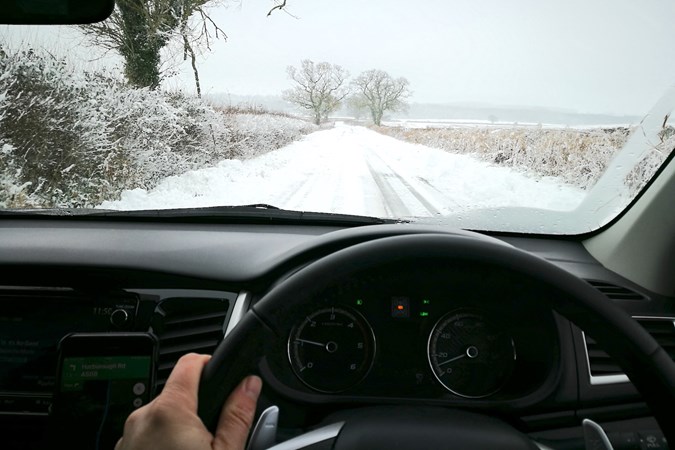
As a result, the Fiat is not only earning its keep - it's earning some respect.
There are few niggles that are actually related to the pickup itself, and these are largely down to Fiat's marketing and specification changes.
Missing Apple CarPlay will probably be rectified in later models, as Mitsubishi is rolling out a new media system on the L200, and there's a point of semantics on how many adjustments are counted on an 8-way electric seat; it has four things that can be moved - distance from wheel, tilt of the base (unusual), height and backrest.
It also has some little features I really appreciate - the A-pillar grab handle is not always present on commercial vehicles, and useful when clambering in on slopes and muddy surfaces. The keyless entry system is reliable, and not overly fussy to use, and the headlights have a good beam pattern and spread for being older technology.
The Fullback looks good, too; I'm looking forward to seeing the Cross version in the metal, and lamenting the lack of sportsbars on my LX, however.

Where it counts, then, there have been no issues. It's exceeded my expectations for performance and handling, is refined on long motorway journeys (the engine note is subdued and even pleasant - something some modern diesel cars fail to achieve), capable on poor terrain and about average on fuel.
I've yet to find a reason to dislike the Fullback despite driving some more expensive, upmarket rivals, and that's very satisfying given the commitment made to lease one.
By Richard Kilpatrick
Mileage: 2107
Actual fuel economy: 31.3mpg
Report 2: From construction to commuting
The Fullback gets thrown into commuter traffic, as plans change and offices beckon
Collection and first drives
Handover of the Fullback was pretty quick; I’m not that used to buying new cars, but the few times I have there’s been more show and tell involved. An absence of floormats was temporarily solved with some from a Fiat 500, and the first tank of diesel was dropped in. Before leaving the forecourt, a suggestion from one of my friends made it to the tailgate; hitchhikers can feel safe with this truck.
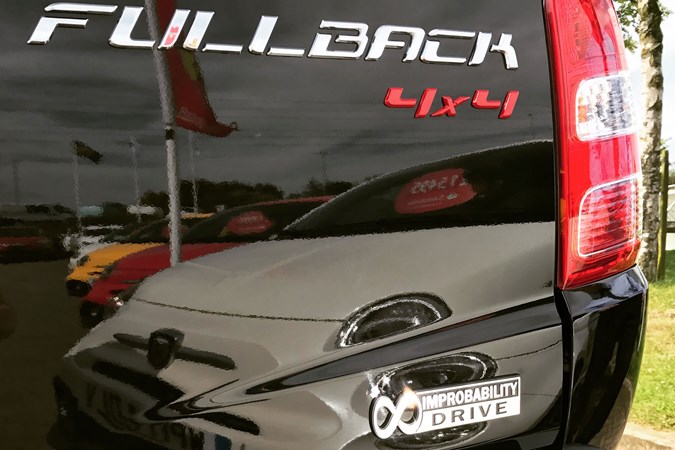
Despite assurances that the lease firm expect some wear, I didn’t want to drive the pickup with an unprotected bed, and got the factory under-rail load liner (leaving some flexibility for sports bars or covers later).
Having found the genuine one for a good price on eBay, I set about installing this myself. Fears of having to drill the new bodywork were unfounded – the screws go into plates stuck on to the tailgate and sides with 3M tape. If you’re planning on getting tie-downs or the 12-volt socket for the back, you’ll want to get those before the load liner.
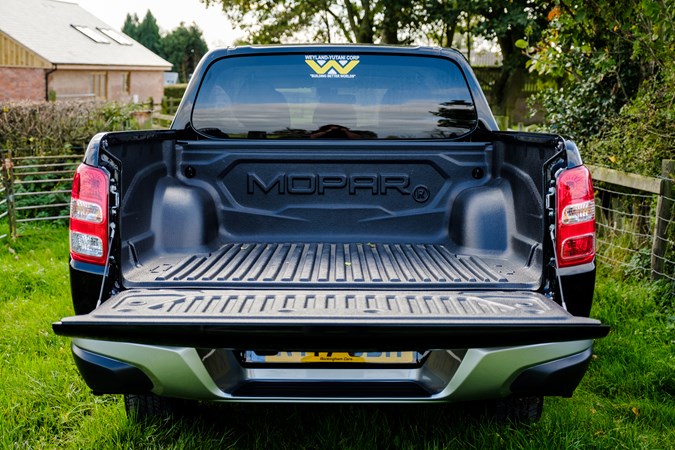
Amusingly it’s branded Mopar. FCA is Fiat Chrysler, after all. But even more appropriately, Chrysler and Mitsubishi have a long standing relationship that started with the L200’s predecessor being sold as a Ram pickup, and lead to many Chrysler cars sharing technology with the Japanese firm.
In some parts of the world there’s a Fullback-style variant sold as the Ram 1200. Even so, the last Chryslers I owned were 5.7-litre V8 powered estate and a 1989 Fifth Avenue; Mopar has very different connotations for me - Americana fed through 4-barrel carbs; performance headers and line-locks rather than load liners and seat covers.
L200 versus Fullback
There are some detail differences that reflect the, let’s say transitional, period of this L200/Fullback relationship. It seems Euro 5 models can be easily spotted by the Professional logo under the Fiat badge; less obvious are the later 2017 tweaks of simpler, flat side steps and a bold 4x4 graphic in red. On both models, manual cars have a Kenwood infotainment system, while automatics have Mitsubishi’s own.
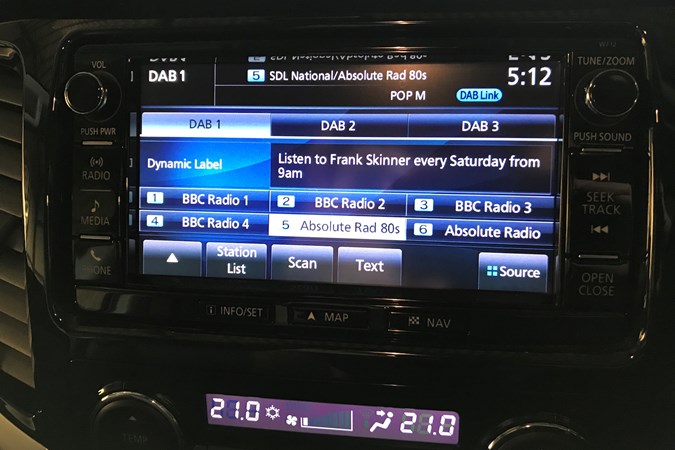
If the Kenwood fitted to the manual version felt dated and sluggish, the Mitsubishi unit is bordering on retro. Hands-free operations are decidedly limited, and browsing media is a slow process that threatens far too much distraction with the unresponsive touchscreen.
With the Kenwood there’s a feeling that as it’s aftermarket, you wouldn’t be wasting a large part of the vehicle by upgrading it to something more useful that supports Apple CarPlay or Android Auto.
Either way, if you like gadgets, the equipment in the VW Amarok is leagues ahead, and the Nissan Navara is at least available with things like surround-view cameras. Given Fiat’s previous efforts with in-car technology, loyal buyers may be surprised by how different this Mitsubishi-sourced system is to their car range.
There are other material differences – the Fullback falls slightly short of the top L200 specification, and Vans Editor CJ Hubbard tells me the Fullback Cross has further oddities, such as losing the useful keyless start. Ambient lighting I can live without, likewise the plastic rather than leather armrest on the centre cubby, but it’s a surprise to find a manual dipping rear view mirror in 2017.
Dealers not quite up to scratch?
The first real shock, though, comes in the form of teething problems with Fiat’s dealers, leasing and commercial vehicles.
Paying the deposit twice is unwelcome and swiftly resolved, but it reflects how little experience some dealers may have with the aggressive broker-beating finance packages Leasys (Fiat’s own leasing company) are promoting.
If the Fullback Cross is going to attract retail customers, the sales staff need to be on the ball.
Hitting the road, and changing plans…
So, there should probably be a month or two cooling-off period on these things. Not because the Fullback is proving to be a bad choice at all, but because a need to be in the office on a daily basis has pushed the Fiat into full-time commuting on Peterborough’s delightful A605 and A14.
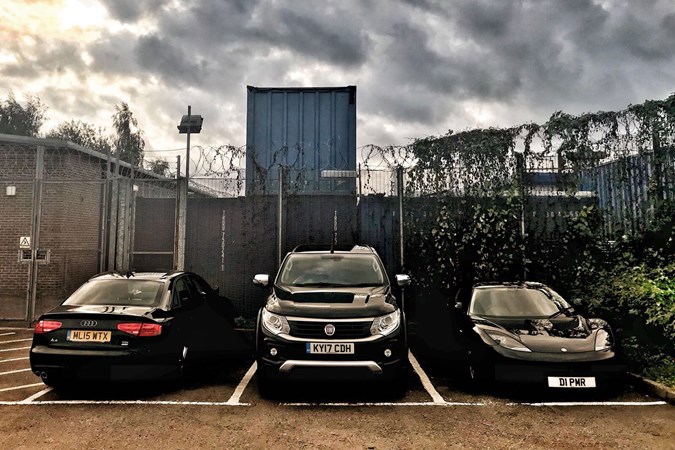
I’d envisaged driving it long motorway distances and then lots of short runs on uncongested rural roads, carrying unwanted detritus in the back. Instead, it’s been joining the daily grind and in theory, almost anything else would be a better fit.
However, despite the aggressive tactics of HGVs and commuters, and keeping up with the traffic flow, the Fullback has actually been an impressive commuter car.
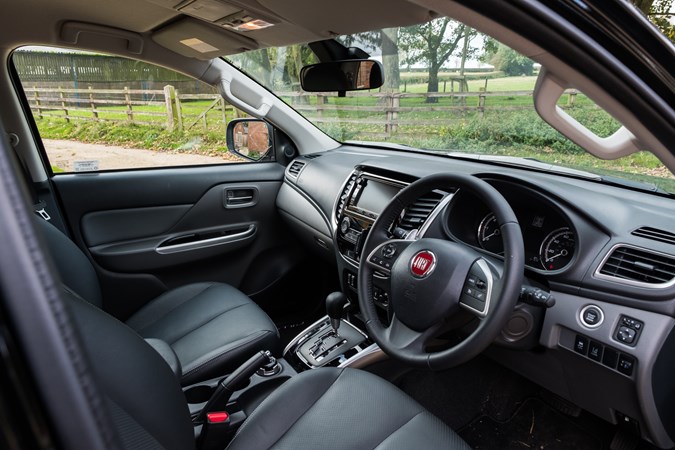
Although lacking the range of adjustment found on executive saloons, the electric seats are remarkably comfortable – superior to the other pickups I’ve encountered so far, though that’s by no means an exhaustive list.
It’s far from tiring to drive, which bodes well for anyone using these for business, and the rather conventional five-speed automatic has well-spaced ratios; compared to some allegedly more sophisticated six-or seven-speed units, it’s calm. There’s a novel thing, where the throttle affects your RPM and speed, rather than constantly hopping around ratios to stay in a narrow powerband.
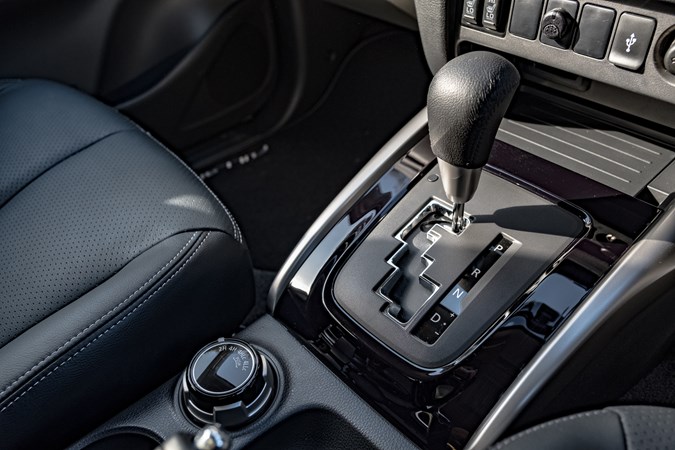
So far the Fullback is averaging 30mpg, with a best of 33mpg on a longer run, and worst of 27.8mpg in a congested rush/wait/rush situation. This is without any form of aerodynamics-enhancing load bay cover, too.
Using the full-time four-wheel drive in cold/stormy weather has had minimal impact on economy the few times it’s felt beneficial; there’s little change in the truck’s attitude when both axles are driven, with none of the drag some systems introduce. When covering mixed surfaces, such as wet, muddy fields then clean tarmac drives, being able to switch and forget is extremely useful.
So far, so good, then. I genuinely have no buyer’s remorse, and despite the options of sophisticated, smaller and more economical cars on the wider test fleet, relish the days when I can use my own car (well, pickup).
There’s a big run coming up, though, as our friends have offered to rehome a cat stressed out by building work. Downside; they live in Devon…
By Richard Kilpatrick
Mileage: 1104
Actual fuel economy: 30.4mpg
Report 1: Richard buys a Fullback
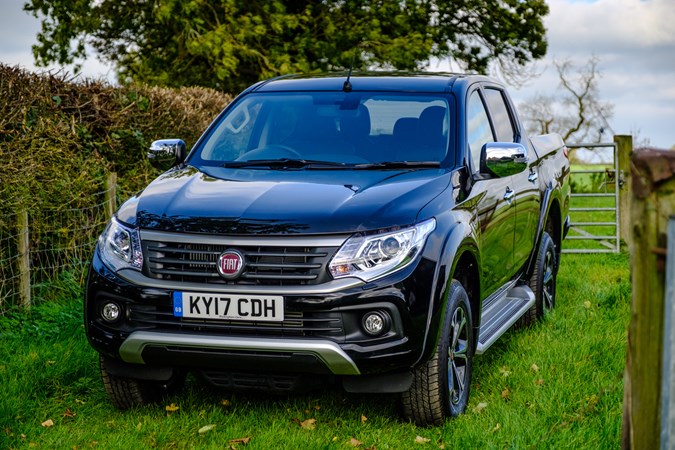
After a couple of years of running secondhand cars as a disciple of bangernomics, it became apparent that two factors were beginning to affect life negatively.
One, the impact on my bank account of frequently replacing parts and cars, and travelling to find the best deals, was as bad as just signing up for a lease car. Two, I was beginning to resemble the cars I drove: shabby, tired and a little disreputable.
So, when work demands suggested a new car would be more appropriate than renewing my fleet of old sheds, I began searching for a suitable long-term companion that could be had for a reasonable monthly amount.
No automatics for the people?
Preferring automatics really reduces the choice; competitive lease prices are generally only available on manual cars.
Yet the sea of silver and grey mid-size executive saloons just didn’t appeal, and when you really value rugged build and longevity, and have a fondness for four-wheel drive, the prices go sky high. Even a popular car like the Skoda Superb works out at almost £500/month if you want the 4x4 automatic version.
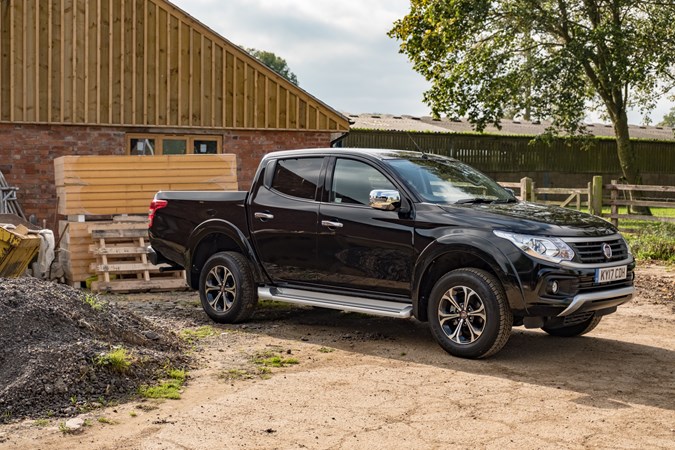
Pickups, however, have a lot of appeal. Not only are they advantageous for sole traders and businesses anyway, you get a robust chassis and suspension that laughs at potholes, a high driving position that suits a photographer’s eye for the landscape, and good resale value. Lifestyle models are generally well equipped, too.
Adding the demand of a family house in need of renovation, the lure of the tax-friendly, high-residual pickup truck became rather hard to ignore.
Van and pickup taxation - everything you need to know
A buyers’ market for pickups?
Presently, the pickup market is fiercely competitive. Based on Parkers Vans reviews, feedback from family and friends, and of course my own tastes, the shortlist came down to the tough Toyota Hilux, the tastefully conservative VW Amarok, and the popular Mitsubishi L200.
All are readily available with automatic transmissions, and marketed by manufacturers and brokers alike with sub-£300/month leasing.
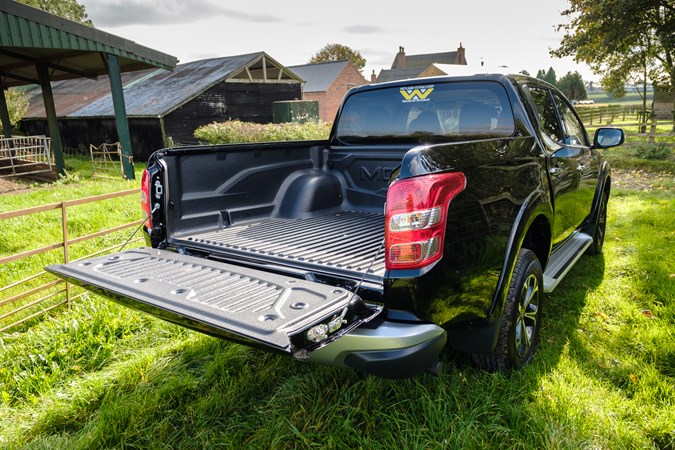
However, my 20,000 miles per year requirement rather ruined those figures, and the best deals involve a four-year commitment; this meant I’d end up spending a small fortune overall.
With those considerations, not even those models designed to specifically appeal to the budget-conscious buyers could help me. The SsangYong Musso and Great Wall Steed may have list prices way lower than the mainstream, but their lease rates still aren’t especially competitive.
Then, lurking among the searches, a relative mystery machine appeared from the brokers with strongly compelling figures: the Fiat Fullback.
Fullback comes in from the subs’ bench
Fiat’s Fullback is a rare sight on UK roads at the moment. Until recently it was only offered by Fiat Professional van dealers and the firm is not known for these kinds of vehicles at all.
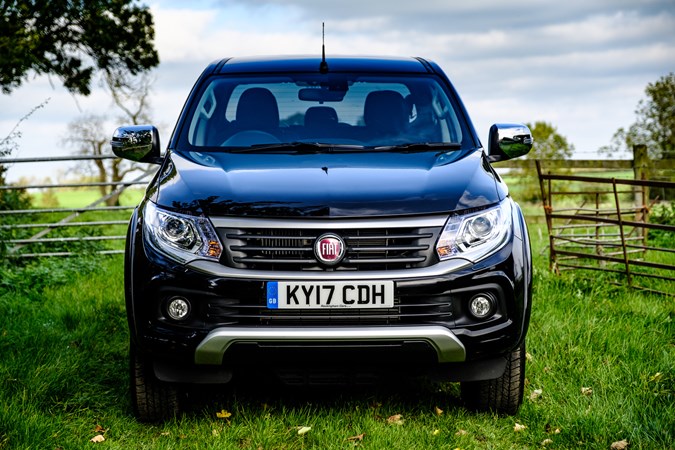
As such, Fiat has made no secret of the Fullback’s origins as a badge-engineered double cab Mitsubishi L200. So it’s actually a truck from my shortlist – albeit one that’s slightly better value for money in range-topping LX form.
As always, the best deals are only available on cars taken from stock, limiting the colour choices, but as the LX has no factory options – only dealer fit accessories – this really isn’t a significant issue.
Test driving the manual
I wasn’t able to test drive an auto, but a spin in the six-speed manual revealed the Fullback’s 181hp diesel engine to be remarkably refined, and performance more than adequate. In fact, it goes 0-62mph in less than 10 seconds.
Comparison with a similarly-priced executive car is perhaps unfair, yet the Fullback LX features a touch-screen infotainment system with DAB radio and sat-nav, heated leather seats, automatic wipers and bi-xenon lights, plus a useful reversing camera.
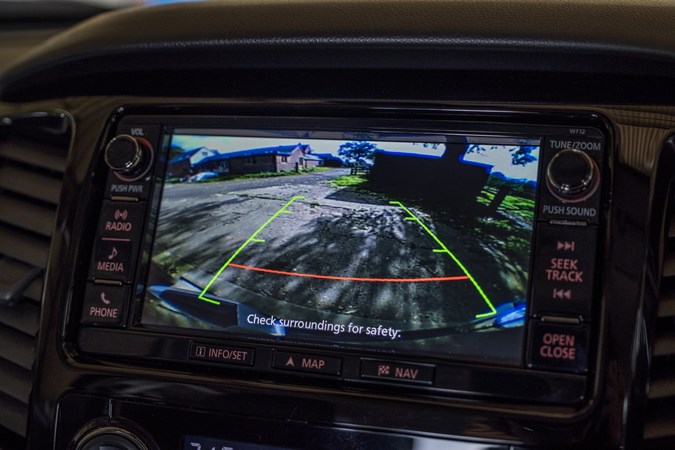
Behind the wheel the traditional advantages of high driving position and a reasonably upright, close windscreen with moderately sized pillars inspired confidence, and large mirrors made lane changes relatively stress-free. Tailgaters can be difficult to spot, though.
If you’re coming to a pickup from a car the length of the rear bed can be a shock – my first set of safety checks on leaving the dealer carpark resulted in a double take to see what was so close behind me. If you’ve ever wondered how your dog feels when startled by their own tail, that’s the closest you’ll get.
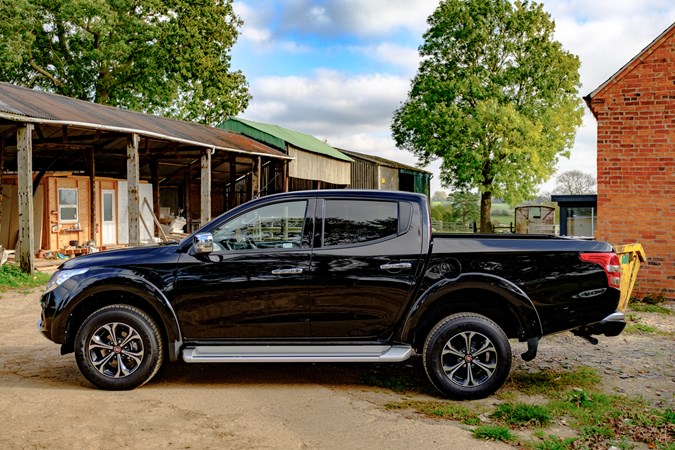
Motorway refinement proved equal – even superior – to many family diesel cars, though ride quality expectations have to be adjusted for the type of vehicle...
Fulltime four-wheel drive seals the deal
One of the most important considerations for me was the ability to use all-wheel drive on the road. Britain is uniquely able to throw mild-but-unpleasant conditions at drivers, and an unladen pickup, no matter how good, can be a little tail happy when traction is lost.
The majority of pickups, including Fiat’s own 150hp Fullback SX, come with a part-time 4x4 system that will wind up if used on merely greasy roads, whereas full-time 4x4 allows extra security in all conditions. It is selectable, too, so two-wheel drive can be used for economy the majority of the time.
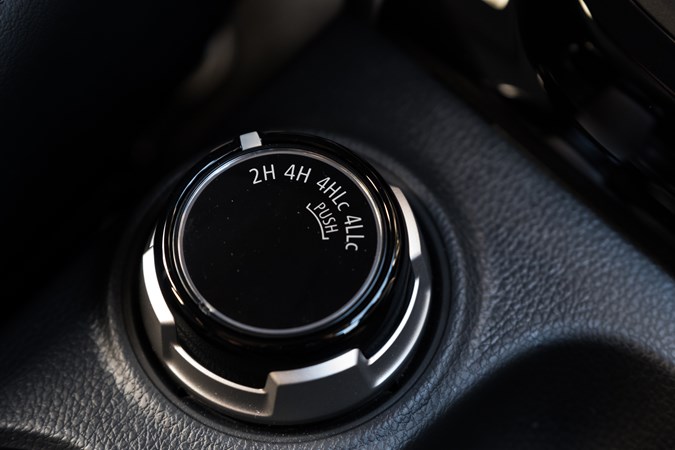
This is the system that comes on the LX. Called Super-Select in Mitsubishi world, it’s also one I’ve used before in a Delica and Shogun, and already trust on and off road. The rotary controller is a nice touch, though. It’s a shame there’s no inclinometer on that large media display!
Sold
The budgetary constraints that have lead me to the Fullback have been a factor, no doubt at all, but the test drive reinforced the consistent praise both the L200 and Fullback have received in reviews; the deposit paid, and order placed. Already limited in colours, the best deals were available on blue, grey or black models already in stock so black was selected.
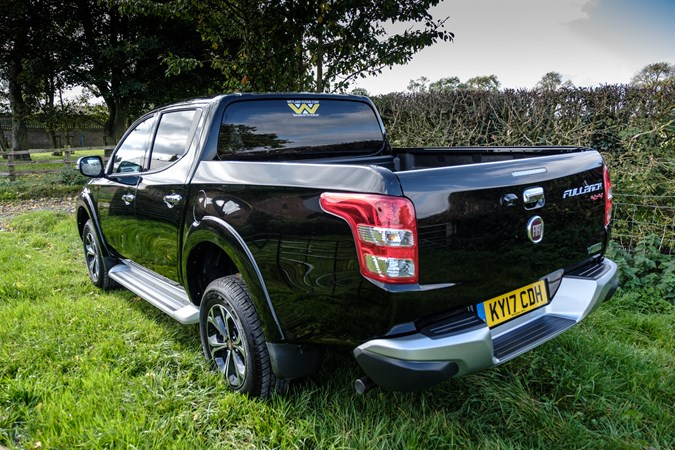
True to their word, my Fullback arrived at Rockingham Cars in Kettering within three weeks of ordering. As this is my own vehicle, it naturally gets some appropriate graphics – diverse uses present a lot of options, including taking it seriously and promoting photography. Of course a fictional building firm wins out.
Pickup finance – really the best deal for sole traders?
Britain’s company car parks formed the spearhead for an invasion of lifestyle pickups in the mid-2000s, and after a brief period of adjustment, the tax benefits that ensured that proliferation – and a concerted effort from the manufacturers to redesign the trucks for a 1.0-tonne capacity even when a hardtop is fitted – have returned.
A double cab pickup with a capacity of 1,050Kg leaves headroom for the standard 45Kg HMRC allows for a hardtop back, and opting for a pickup ensures half the BIK liability and commercial allowances for fuel.
What’s more, sole traders and businesses can enjoy a variety of approaches including Annual Investment Allowance for plant, rather than the more complex capital allowances for passenger cars.
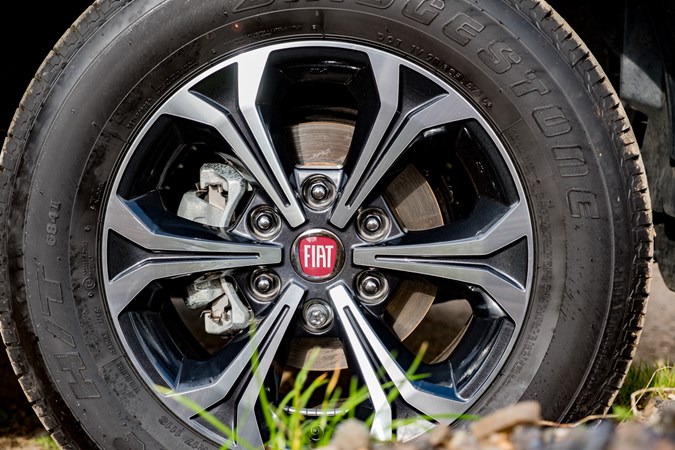
In the Fullback’s case, these areas were enhanced by low initial rentals, incredibly high specification and short contract terms from the brokers.
Yet these were still all bettered by a local Fiat dealer, resulting in a two year contract for just £1,081 initial rental and £364/month including VAT. Not bad when the inc-VAT on the road price for a Fullback LX automatic is £31,384.
A more normal 10,000-mile deal can be as little as £800 down and £260/month inclusive of VAT – and most customers for this class of vehicle will be able to claim the VAT back. You try finding a car with this level of capability for similar value.
More soon.
By Richard Kilpatrick
Fiat Fullback LX 180 auto long-term test review
List price: £25,245 (ex VAT)
Price as tested: £25,897 (ex VAT)
Engine: 2.4-litre turbodiesel four-cylinder, 181hp, 430Nm
Transmission: five-speed automatic gearbox, all-wheel drive
Claimed fuel economy: 37.7mpg
Actual fuel economy: 31.3mpg


